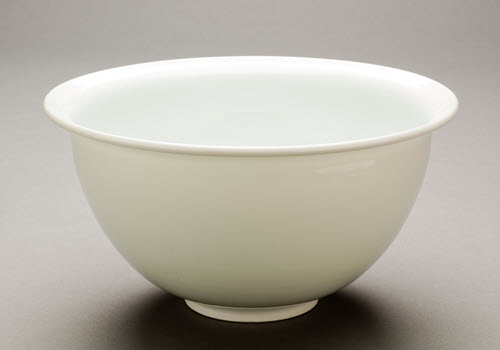In order to answer the question of “What is Porcelain?,” the process of creating a porcelain clay body begins with selection of the purest of clays, kaolin (china clays), plus feldspar, silica, and a plasticizer, a critical ingredient I add thoroughly mixed with water (blunged). At high temperature, in my case cone 10 (between 2350 and 2386 degrees F depending on speed of firing), both in a reducing atmosphere of a gas-fired kiln and increasingly in the (mostly) oxidizing atmosphere of an electric kiln, a melt is created, continuing to the level where the pot is at the point of collapse.
Porcelain (and stoneware) clay bodies are a fusing together of alumino-silicate minerals at high temperature, and the result is quite literally stone. As a potter I am combining decomposed minerals of the earth, mixing them together in a nearly infinite variety of combinations for the clay bodies and glazes I create, forming and glazing them and returning them by way of intense heat to their original form (stone).

Defining “What is Porcelain?”
All high-fire clays used in the formation of stoneware and porcelain come from the decomposition of feldspathic rock, including fireclays and ball clays to create stoneware bodies and kaolin (china clays) to create porcelain clay bodies. Some kaolin clays may contain so few impurities that, in combination with feldspar, silica and a plasticizer, they may result in fired porcelain becoming translucent when held up to a light source. This is my goal, to create porcelains that are close to glass. Again answering the question, “What is porcelain?”, porcelain provides a feature of primary importance to my aesthetic, a white background, against which transparent or translucent glazes can achieve maximum clarity of glaze color.
What is a Clay Body?
The term “clay body” is used because the clays and associate minerals used to compose porcelain (and stoneware) must come into balance, become a fused “body,” to achieve a favorable outcome for the pots I throw on the wheel. A crucial addition to both porcelain and stoneware bodies is feldspar, an alumino-silicate mineral which displays a proportionately higher content of fluxes than kaolin or fireclay. A flux is “an oxide which promotes ceramic fusion by interaction with other oxides.”[1]
At high temperature, feldspar lowers the melting temperature of highly refractory kaolin clays (and added silica) so the fired clay body may be very close to zero percent absorption of water. Also, at or near top firing temperature, a primary phase of silica known as cristobalite is ejected from the types of clays used to for stoneware and porcelain clay bodies and must be ‘taken into the melt’ through a sufficient quantity of feldspar.
Lastly, in defining “What is Porcelain?”, I create vitreous porcelains to fit my throwing requirements and my desire for white fired color. To do this I have used the techniques rigorously discussed in Jim Robinson’s seminal Studio Potter article for 35 years.[2]
Next, The Process Begins……..!
[1] Definition of Flux, p. 150, The Potter’s Dictionary of Materials and Techniques, Fifth Edition, by Frank and Janet Hamer
[2] See “Body Building for Potters: A Clay-Blending Formulary, The Studio Potter, Vol. 16 No. 2, pp.73 – 82

